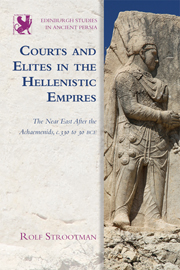Book contents
- Frontmatter
- Contents
- List of Illustrations
- Acknowledgements
- Abbreviations
- The Hellenistic Dynasties
- Series Editor's Preface
- Map
- Introduction: Court and Empire in the Hellenistic Near East
- PART I SETTING THE SCENE
- PART II THE COURT AS A SOCIO-POLITICAL SYSTEM
- PART III CEREMONIAL AND RITUAL
- Conclusion
- Bibliography
- Index
Series Editor's Preface
Published online by Cambridge University Press: 05 September 2014
- Frontmatter
- Contents
- List of Illustrations
- Acknowledgements
- Abbreviations
- The Hellenistic Dynasties
- Series Editor's Preface
- Map
- Introduction: Court and Empire in the Hellenistic Near East
- PART I SETTING THE SCENE
- PART II THE COURT AS A SOCIO-POLITICAL SYSTEM
- PART III CEREMONIAL AND RITUAL
- Conclusion
- Bibliography
- Index
Summary
Edinburgh Studies in Ancient Persia focuses on the world of ancient Persia (pre-Islamic Iran) and its reception. Academic interest and fascination in ancient Persia has burgeoned in recent decades and research on Persian history and culture is now routinely filtered into studies of the Greek and Roman worlds; Biblical scholarship too is now more keenly aware of Persian-period history than ever before, while, most importantly, the study of the history, cultures, languages and societies of ancient Iran is now a well-established discipline in its own right.
Persia was, after all, at the centre of ancient world civilisations. This series explores that centrality throughout several successive ‘Persian empires’: the Achaemenid dynasty (founded c. 550 BCE) saw Persia rise to its highest level of political and cultural influence, as the Great Kings of Iran fought for, and maintained, an empire which stretched from India to Libya and from Macedonia to Ethiopia. The art and architecture of the period reflect both the diversity of the empire and proclaim a single centrally-constructed theme: a harmonious world-order brought about by a benevolent and beneficent king. Following the conquests of Alexander the Great, the Persian Empire fragmented but maintained some of its infrastructures and ideologies in the new kingdoms established by Alexander's successors, in particular the Seleucid dynasts who occupied the territories of western Iran, Mesopotamia, the Levant and Asia Minor.
- Type
- Chapter
- Information
- Courts and Elites in the Hellenistic EmpiresThe Near East After the Achaemenids, c. 330 to 30 BCE, pp. xvii - xviiiPublisher: Edinburgh University PressPrint publication year: 2014



